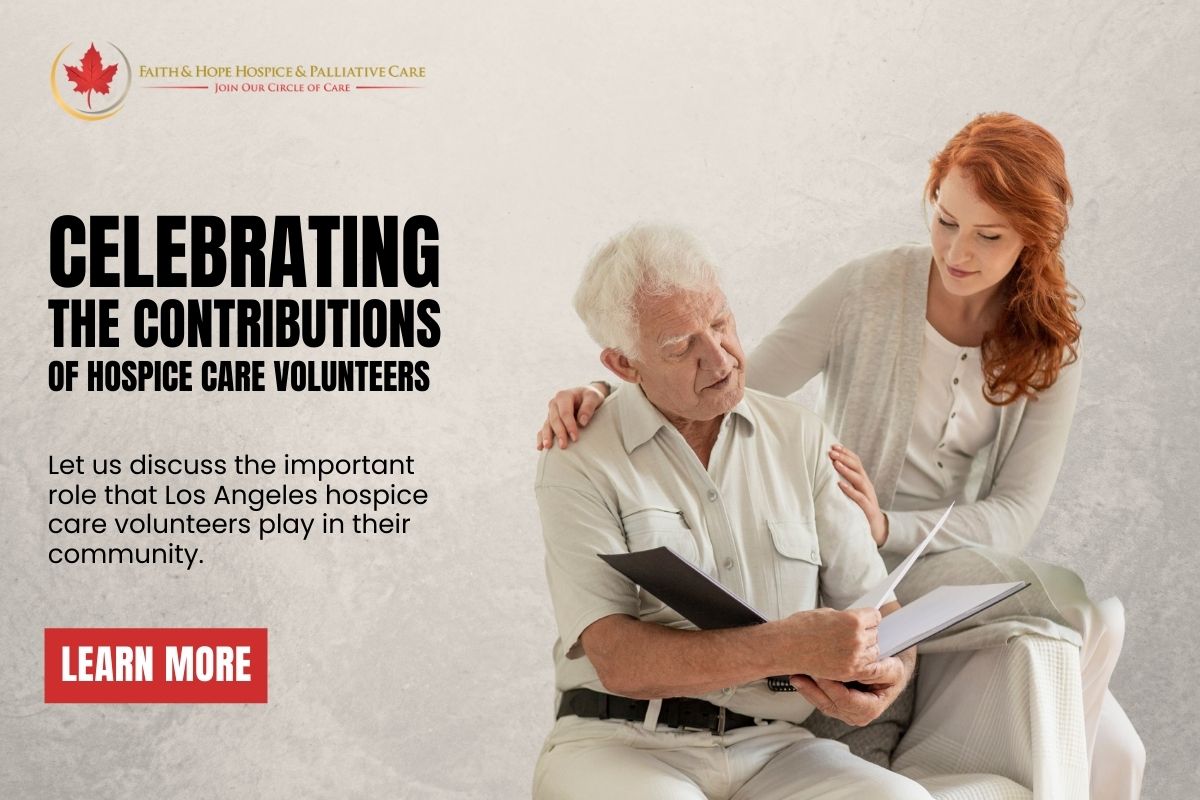
- By: administrator
- Blog
- No Comments
In the realm of end-of-life care, hospice services play a vital role in providing comfort, compassion, and support to patients and their families. While the focus often remains on the medical staff and professionals, the unsung heroes of hospice care are the volunteers who selflessly dedicate their time, energy, and hearts to make a difference in the lives of those facing their final journey. In this blog, we shed light on the invaluable contributions of Los Angeles hospice care volunteers and their impact on the lives of patients and families.

Compassion in Action:
Hospice care volunteers possess a unique gift of compassion. Their ability to empathize and connect with patients and families is a cornerstone of the hospice philosophy. Whether they’re holding a hand, listening to stories, or simply providing a comforting presence, volunteers offer a sense of emotional solace that can make all the difference in someone’s final days.
Enhancing the Quality of Life:
Beyond medical treatment, volunteers focus on improving the quality of life for patients. They engage in various activities, such as reading to patients, playing music, arranging small celebrations, or fulfilling simple wishes. By creating memorable experiences, they bring moments of joy and happiness to patients, helping them cherish their remaining time.
Supporting Families:
Hospice care volunteers also extend their support to the families and friends of patients. Navigating the complexities of end-of-life care can be emotionally overwhelming, and volunteers often provide a listening ear and a shoulder to lean on. Their presence can alleviate stress, allowing families to focus on making the most of their time with their loved ones.
Enriching Cultural and Spiritual Experiences:
Recognizing the diversity of patients, hospice care volunteers embrace cultural and spiritual sensitivity. They respect and accommodate individual beliefs and practices, ensuring patients find solace and connection during their final journey.
Bridging the Gap in Care:
In busy healthcare settings, volunteers play a crucial role in bridging the gap in care. They complement the work of medical professionals by offering personalized attention and a human touch that might be challenging to provide consistently within the confines of a clinical environment.
Fostering Community Involvement:
Hospice care volunteers are often deeply embedded in their local communities. Their dedication to serving those in need helps foster community involvement and awareness about end-of-life care. Their efforts inspire others to join in this noble cause, expanding the network of support for those facing terminal illnesses.
Gaining Personal Fulfillment:
Volunteering in hospice care is a transformative experience for the volunteers themselves. Many volunteers speak of the profound sense of fulfillment and purpose they derive from their service. The connections they build with patients and families often leave a lasting impact on their own lives, teaching them valuable lessons about empathy, resilience, and the fragility of life.
The Training and Dedication of Volunteers:
Behind every effective hospice care volunteer lies a foundation of rigorous training and continuous learning. Before they even set foot in a patient’s room, volunteers undergo specialized training sessions that equip them with the skills and knowledge to provide compassionate, non-medical care. This includes understanding the physical and emotional changes at the end of life, cultural competence, effective communication, and the ethics of confidentiality. Their dedication doesn’t stop there. Many volunteers continue to attend workshops and seminars, ensuring they remain updated on best practices and can offer the best possible support.
Challenges Faced by Hospice Care Volunteers:
The role of a hospice volunteer isn’t always easy. They regularly encounter grief, loss, and emotional pain. At times, they might support a patient who doesn’t have any family or friends visiting, which can be emotionally taxing. Yet, these volunteers muster the strength and resilience to be there, day in and day out, offering a beacon of hope and solace. Their ability to manage their own emotions, to provide steadfast support, and to compartmentalize personal feelings speaks volumes about their strength of character.
Holistic Care – The Mind, Body, and Spirit:
Hospice care volunteers recognize that end-of-life care isn’t just about physical comfort. They cater to the mind, body, and spirit. For instance, some volunteers may be trained in alternative therapies like guided imagery, gentle touch, or even aromatherapy, providing additional avenues of relaxation and comfort. Spiritually, they might assist in facilitating religious rituals, prayers, or simply engaging in profound conversations about the meaning of life, as per the patient’s beliefs and desires.
Tailored Approaches:
Each patient is unique, with their own stories, preferences, and needs. Volunteers often take the time to know each individual personally, understanding their likes, dislikes, hobbies, and more. This tailored approach ensures that every interaction, be it a conversation or an activity, resonates deeply with the patient.
Raising Awareness:
Outside of direct patient care, many hospice volunteers take on advocacy roles. They engage in community outreach, participate in events, and even engage in educational seminars to raise awareness about the benefits of hospice care. Their firsthand experiences lend credibility and authenticity to their message, helping to dispel myths and address misconceptions.
End-of-life Celebrations:
While the focus of hospice care is on the patient’s final journey, it is also about celebrating a life well-lived. Volunteers often play a pivotal role in organizing “celebration of life” events, where patients and families can reminisce, share stories, and even leave behind legacies like letters or recorded messages.
A Few Personal Narratives:
Stories have a powerful way of connecting and resonating with readers. You might consider adding a few personal narratives or testimonials from volunteers, detailing their experiences and the profound moments they’ve shared with patients and families.
Conclusion
As we applaud the indispensable role of helpers at hospice care in Los Angeles, CA, let us not forget the tireless contributions of the hospice care volunteers. These selfless individuals are the pillars of support, enriching the lives of patients and loved ones during their most challenging moments. Their boundless compassion, unwavering dedication, and commitment to enhancing the quality of life make them true unsung heroes in the field of end-of-life care. Let us recognize and celebrate these remarkable individuals for their vital role in making the final journey for patients and families as comfortable and meaningful as possible.
If your loved one needs Los Angeles hospice care, contact us at (877) 797-1977 or email info@faithandhopehospice.com.
